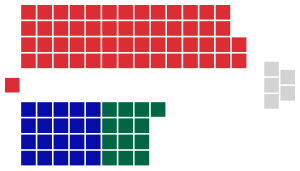New South Wales state election, 1999
|
|
||||||||||||||||||||||||||||||||||
|---|---|---|---|---|---|---|---|---|---|---|---|---|---|---|---|---|---|---|---|---|---|---|---|---|---|---|---|---|---|---|---|---|---|---|
|
||||||||||||||||||||||||||||||||||
|
All 93 seats in the New South Wales Legislative Assembly and 21 (of the 42) seats in the New South Wales Legislative Council 47 Assembly seats were needed for a majority |
||||||||||||||||||||||||||||||||||
|
||||||||||||||||||||||||||||||||||

Legislative Assembly after the election
|
||||||||||||||||||||||||||||||||||
|
||||||||||||||||||||||||||||||||||
Elections to the 52nd Parliament of New South Wales were held on Saturday, 27 March 1999. All seats in the Legislative Assembly and half the seats in the Legislative Council were up for election. The Australian Labor Party, led by premier Bob Carr won a second term with a 7% swing against the Liberal Party of Australia and National Party of Australia, led by Kerry Chikarovski.
The poll was the first to be held after two key changes to the electoral system. In 1997, the number of electoral districts was reduced from 99 to 93. In 1995, fixed four-year terms were introduced.
The Labor Party’s victory at the 1995 election was built on a number of specific promises, backed by a well directed marginal seat campaign. On taking office, the Carr Government faced difficulties presiding over a public sector that had fundamentally changed during the seven years of the Greiner and Fahey Governments. The major dynamic of the Carr Government’s first term was to be the clash between the old fashioned promises that won the 1995 election and the new orthodoxy of public sector financial accountability.
This new orthodoxy had its genesis in the election of the Hawke Government at the 1983 Federal election. The new financial strictures applied by Canberra to deal with the nation’s trade imbalance created problems that forced change on the States. While the term microeconomic reform was not yet in use when the Greiner Government was elected in 1988, New South Wales became the first State that committed itself to a fundamental examination of the role and activities of the public sector. Focussing initially on the efficiency of service delivery and drawing distinctions between commercial functions and core Government services, the process evolved into using market mechanisms to improve the efficiency of services for which the public sector had previously been the monopoly provider. Later, the Jeff Kennett government in Victoria and the Howard Government in Canberra were to take the process further with the wide scale use of privatisation and the outsourcing of services.
...
Wikipedia


